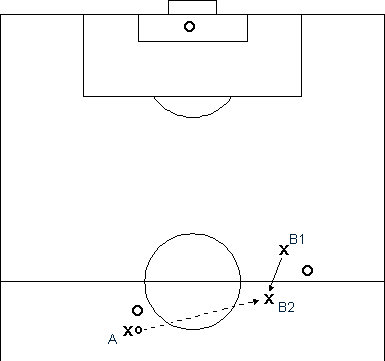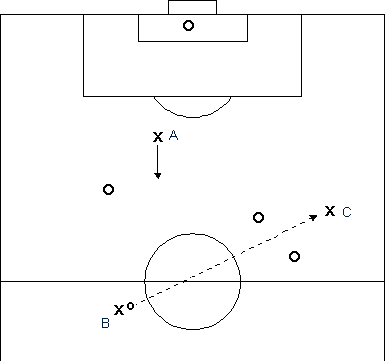 printer friendly version printer friendly version
Probably the most misunderstood of all calls by parents, coaches and even referees are "Handball" and "Offside". Here is an in depth explanation of what makes up those calls (also a pretty simple flow chart here).
Handball
Deliberately handling the ball, except by the goalkeeper within his or her own penalty area. Handling the ball is a foul when a player touches the ball with any part of the hand or arm while intending to control the ball. The referee should not call the "hand ball" foul if a player:
* Is not trying to control the ball, or
* Is instinctively protecting himself or herself from injury.
The penalty results in a direct free kick for the opposing team.
Offside Position
It is not an offence in itself to be in an offside position.
A player is in an offside position if:
He is nearer to his opponents' goal line than both the ball and the second last opponent.
A player is not in an offside position if:
He is in his own half of the field of play or he is no nearer to the opponent's goal line than two or more opponents or if he is no nearer to the opponent's goal line than the ball.
Offence
A player in an offside position is only penalized if, at the moment the ball touches or is played by one of his team, he is, in the opinion of the referee, involved in active play by:
Interfering with play or interfering with an opponent or gaining an advantage by being in that position.
No Offence
There is no offside offence if a player receives the ball directly from:
A goal kick or a throw-in or a corner kick.
Infringements/Sanctions
For any offside offence, the referee awards an indirect free kick to the opposing team to be taken from the place where the infringement occurred.
Law 11 Overview
Pass to a Team Mate

A Passes the ball to B.
B is off-side because he is in front of A and is nearer to his opponents' goal-line than at least two opponents when the ball was passed by A.
Pass to a Team Mate

A plays the ball forward to B who is level with the second last defender.
B is not off-side since, at the moment the ball was played by A, he was not nearer to his opponents' goal-line than at least two opponents.
Pass to a Team Mate

A plays the ball forward to B who is level with the second last defender.
B is not off-side since, at the moment the ball was played by A, he was not nearer to his opponents' goal-line than at least two of his opponents.
Pass to a Team Mate

A plays the ball forward to B who is level with the second last defender.
B is not off-side since, at the moment the ball was played by A, he was not nearer to his opponents' goal-line than at least two of his opponents.
Pass to a Team Mate

A crosses the ball forward from outside the penalty area.

B runs from Position 1 and collects the ball as it lands at Position 2.
B is off-side since, at the moment the ball was played by A, he was nearer to his opponents' goal-line than at least two of his opponents and gained an advantage by being in active play.
Pass to a Team Mate

A passes the ball to B who runs from Position 1 to Position 2 to play it.
B runs from Position 1 and collects the ball as it lands at Position 2.
B is not off-side because at the moment the ball was played by A, he was not in an off-side position since he was not in front of the ball and was not nearer to his opponents' goal-line than at least two of his opponents.
Inter-passing with a Team Mate

A plays the ball to B from Position 1 and runs forward to receive the return pass.

B plays the ball to A who is now in Position 2.
A is off-side since at the moment the ball was played forward to him by B, he was nearer his opponents' goal line than at least two of his opponents and gained an advantage by being in active play.
Interfering with an Opponent

A shoots for goal and the ball enters the net.
B is standing in front of the goalkeeper.
The goal would not be allowed since B who is in an off-side position, is involved in active play and is interfering with an opponent.
Shot at goal

A shoots for goal and scores.
Although B is in an off-side position, he is not involved in active play and the goal would be allowed.
Ball Rebounding from Goal Posts or Crossbar

A shoots for goal and the ball rebounds from the post to B who kicks the ball into goal.
The goal would be disallowed since B, who was in an off-side position when the ball was last played by A, was in active play and gained an advantage by being in that position.
Shot Rebounds from Goalkeeper

A shoots the ball at goal and the ball rebounds from the Goalkeeper to player B.
The goal is disallowed since B, who was in an off-side position when the ball was last played by A, was in active play and gained an advantage by being in that position.
Ball Rebounding from Goal Posts or Crossbar

A shoots for goal and the ball rebounds from the post to B who kicks the ball into goal.
The goal is disallowed since B, who was in an off-side position when the ball was last played by A, was in active play and gained an advantage by being in that position.
Not Interfering with an Opponent

A shoots for goal and scores.
Although B is lying injured in an off-side position, he is not involved in active play.
The goal would be allowed
Interfering with an Opponent

A shoots for goal and the ball enters the net.
B, who is lying injured in the goal area and in the path of the ball, would be penalized for off-side. By his presence, however accidental, he is involved in active play and is interfering with an opponent.
Corner Kick

A takes a corner kick and the ball goes to B.
B shoots for goal and the ball is touched by C and enters the goal. The goal is not permitted since C was in front of the ball and there were not at least two opponents between him and the goal-line when it was last played by B.
Corner Kick

A corner kick is taken by A and the ball goes to B who scores.
Although B has only one opponent between him and the goal-line, the goal is allowed since a player cannot be off-side if he receives the ball direct from a corner kick.
Throw-in

A throws the ball to B who scores.
The goal is allowed.
Although B is in front of the ball and there is only one opponent between him and the goal-line, he is not off-side because a player cannot be offside if he receives the ball direct from a throw-in.
Pass to a Team Mate

B plays the ball ahead of A who is in his own half.
Although there are not at least two opponents nearer their own goal-line at the moment when B played the ball, A is not off-side since a player cannot be off-side in his own half of the field of play.
Pass to a Team Mate

A passes the ball forward.
B runs from Position 1 and collects the ball at Position 2.
B is off-side since, at the moment the ball was played by A, he was nearer to his opponents' goal-line than at least two of his opponents and gained an advantage by being in active play.
Offside - A

The ball is kicked to the goalkeeper by defender D.
An attacking player A runs towards the goalkeeper to challenge him.
Offside - B

The goalkeeper kicks the ball up-field and the attacking player A turns to take up an onside position.
Offside - C

The ball is intercepted by player B, a team-mate of the attacking player. It is transferred to another team-mate, player C, on the wing.
Although the attacking player A is in an off-side position, he would not be penalized since he is not involved in active play. |